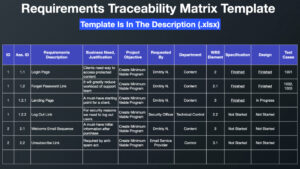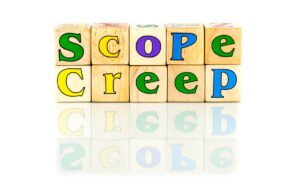How often has a project failed because the people involved needed a better understanding of what was required? Inadequate or inaccurate communication can cause considerable damage to vital projects, setting a company’s business plan back and causing it to fall behind the competition.
And the solution has to be more than “Well, people should communicate better, then!” For example, an organization could have several critical projects going on simultaneously, with each project having a bunch of requirements that must be met. That’s why projects need a requirements traceability matrix or RTM for short.
If that term is new, you’ve come to the right place. This article explores the concept of the requirements traceability matrix, including its definition, importance, parameters, types of matrices, and advantages of an RTM.
We will even have time to check out a requirements traceability matrix template and other tools available to expedite the process.
But before we immerse ourselves in RTMs, we should establish some definitions.
Check Out Our Post Graduate Program in Project Management
What Do We Mean by Requirements Traceability?
Before we explore the matrix, let’s walk things back a little further and define requirements. A requirement is a task that must be completed to deliver the final product or project. Requirements traceability is a means for the product team to track these requirements and ensure they’re fulfilled. Bear in mind that each decision made over the project can change and impact the project’s requirements. Hence, the team needs to understand that impact, so they need the RTM’s transparency.
Requirements traceability guarantees that each essential project requirement and the ultimate delivery of a stable, usable product has been achieved. Of course, tracking the variables the team can encounter in a project’s development life cycle takes time. However, documentation ensures that the team knows all essential points and that everything gets included.
Now that we’ve defined requirements and requirements traceability, let’s define the requirements traceability matrix.
What is the Requirements Traceability Matrix?
A RTM is a document or tool the project manager uses to track all project requirements as it progresses through product development. The RTM is documentation that confirms that all product requirements have been fulfilled. This resource helps monitor deliveries by providing a traceable digital thread for each demand from the project’s start to finish.
The RTM lists requirements, tests, test results, and any issues that may have arisen throughout testing that must be addressed to conclude the project successfully. In summary, the requirement traceability matrix’s chief purpose is to validate that all requirements have been checked with test cases so that no functionality is left unchecked during software testing.
Now let’s look at the importance of the RTM in testing and project management.
Note: Creating a comprehensive Work Breakdown Structure (WBS) in Project Management is essential for successful project planning and execution
Why is an RTM Important?
Here are the main reasons why a requirements traceability matrix is essential.
1) Meeting Goals. When properly executed, traceability follows the life of a requirement, starting when the requirement originates and continuing through the fulfillment of the requirement. Thus, it ensures that your requirements meet your original goals.
2) Running the Right Tests. Requirement traceability helps the quality assurance (QA) team understand what items need to be tested. In addition, this function improves test coverage by mapping test cases back to their requirements. So, QA runs the proper tests and will show that the requirements have been adequately put into action.
3) Making Decisions. Requirements traceability can also be used for decision-making throughout the product development life cycle. For example, you’ll be able to understand how requirements could impact product design. Additionally, if a requirement changes, you can analyze the change’s impact across development.
4) Project Management. Traceability shows you exactly how far you’ve progressed, letting you better manage the scope of your requirements. For example, if you link your requirements to tests, you will understand how to meet all requirements and ship the product on time.
Also Read: Understanding Scope in Project Management: Definition and Importance
Types of Traceability Test Matrices
There are three main types of traceability test matrices.
Forward traceability
This matrix is developed at the project’s beginning to ensure the product moves in the right direction. The term “forward traceability” describes the process of mapping requirements to test cases.
Backward traceability
Also called “reverse traceability,” it refers to the process of matching test cases to requirements. It lets managers track a request’s source. Backward traceability also ensures that the current product is on track. Project managers use backward traceability to ensure that the project scope stays the same due to the addition of design components, codes, tests, or other activities not listed in the initial requirements.
Bidirectional traceability
A bidirectional matrix tracks the requirement “forward” by looking at the deliverables; output and “backward” by referencing the requirement initially specified in the project’s initiation phase. This matrix lets teams have total visibility into all specifications via analyzing defects, building, testing, tracking changes, etc.
The Advantages of a Requirements Traceability Matrix
The requirement traceability matrix plays an essential role in project management. The RTM’s primary purpose is to keep track of requirements and their source, trace the shifts, and show how the requirement will be delivered throughout the project’s life cycle.
Because all the project details from the client’s end have already been established, the RTM helps project managers construct a viable action plan for the pipeline project and implement it ahead of the curve. Additionally, managers can accurately estimate resource requirements based on project activities and start the requisition process. As a result, the resource manager can identify and assign the best-fit resources to ensure successful project delivery.
During the validation process, the RTM displays different test scenarios and test execution statuses for various functionalities. The RTM also helps incorporate ad hoc change requests or modifications. Since the team will have all this information at their fingertips, they can effectively realign their efforts with the new expectations.
Finally, the requirements traceability matrix diminishes the risk of defects and missed objectives. The RTM helps project managers evaluate, identify, and mitigate threats before they turn into issues.
How Do You Create a Requirements Traceability Matrix?
Project managers looking to create an effective traceability matrix must define the project’s goals and include all its essential aspects. Here’s a list of typical steps to create a RTM.
1) Define the goal as dictated by the client’s needs. First, the project manager must meet the client and ascertain the latter’s business needs and expectations. Then, the manager should collect all relevant information for the project and break down each goal into milestones.
2) Assemble all necessary documents. Gather all relevant documents needed to build a solid RTM. These documents include a Business Requirement Document (BRD), Functional Requirement Document (FSD), and a Technical Requirement Document (TSD). These documents, prepared by the QA team, should include all test scenarios and cases.
3) Generate a traceability matrix template. Create your template. There are many right ways to create an RTM. See the example further below.
4) Copy and paste the into the RTM. Then, add the requirements, test cases, results generated so far, and issues to your spreadsheet.
5) Validate end results. Finally, take all the requirements through the testing process. The QA team tests all functionalities (FR) under business requirements (BR). The team ensures that every feature of the e-commerce application (e.g., sort by, filters, payment methods) has been completely and thoroughly tested and operating smoothly.
Which Parameters Should Be Included in the Requirements Traceability Matrix?
Your requirements traceability matrix must include the following components.
1) Req #. Each project requirement has a requirement number. List them on your RTM in numerical order, grouping them by function.
2) Name. Enter the name and a brief description of each requirement.
3) RFP #. Short for Request for Proposal (RFP), here’s where you specify the requirement’s identification number as listed in the RFP.
4) DDD #. This component is known as the Deliverable Definition Document but is also called the Deliverable Expectation Document or DED. Use the RFP number as a reference for the DDD created for the requirement.
5) PPT #. List the Task and MS Project Subtask numbers associated with the requirement.
6) TS #. This field covers test scripts, which must be prepared for testing.
7) Verification. Here is where you record the completion of the signoff process.
Also Read: Understanding Project Management: A Comprehensive Guide
The Requirements Traceability Matrix in Project Management Phases
Project managers should consider the following steps when incorporating an RTM into the project.
1) Create the matrix at the start of the project (obviously!)
2) Track all the requirements and whether they’re being met by the current design and process
3) Help create the RFP, Deliverable Documents, Project Plan Tasks, and Test Scripts
4) Help guarantee that all the system requirements were met during the verification process
Ultimately, the RTM enhances the scope management process and assists with quality management and process control. Consider the RTM documenting the relationships and connections between the project’s initial requirements and the final product or service created.
Requirements Traceability Matrix Tools
Fortunately for the hard-working project manager, plenty of tools are available to make the job easier. Here are three popular RTM tools worth looking at.
1) Modern Requirements4DevOps. This powerful RTM tool integrates with Microsoft’s Azure DevOps, TFS, and VSTS and lets project managers automate requirements, accelerate project velocity, and enjoy traceability through every phase of the process.
2) ReQtest. This cloud-based tool offers teams traceability from a project’s start to finish. ReQtest boasts features like bug tracking, requirements management, and test management. It also includes a highly customizable requirement module that helps project managers quickly evaluate and trace changes.
3) Visure Requirements. This state-of-the-art RTM tool is geared toward business-critical and safety-critical industries. Visure Requirements becomes the backbone of the RTM process, handling all the requirement-related information (e.g., change requests, tests, requirements, risks, etc.), their relationships, and user interactions. In addition, Visure Requirements helps enforce and standardize the defined processes throughout the organization, tackle any lifecycle changes, and formalize standard requirements specification structures.
Requirements Traceability Matrix Template: A Sample
Let’s look at an example of a requirements traceability matrix template. Here’s a sample matrix template provided by Simplilearn.com. Notice howit incorporates all the elements we’ve previously discussed. Note that many different kinds of templates are available, each one suited to the team’s unique needs.
How Would You Like Certification in Project Management?
If you’re interested in getting a certificate in project management, Simplilearn, in collaboration with the University of Massachusetts, offers an excellent six-month online bootcamp to meet your project management needs. This certification course is aligned with PMI-PMP® and IASSC-Lean Six Sigma and incorporates live online classes and capstone projects that teach you relevant, in-demand project management skills like:
- Project Management
- Agile Management
- Customer Experience Design
- Digital Transformation
- Design Thinking
- Leadership Skills
- Lean Six Sigma Green Belt (LSSGB)
- Project Risk Management
You can earn 146 PDUs to maintain your CCR for PMI-related certifications. After completing the bootcamp, students receive their certificate and an offer of membership in the UMass Amherst Alumni Association.
Indeed.com reports that project managers in the United States earn an annual average salary of $83,658, which can go as high as $130,690. The business world needs good project managers, so don’t delay. Sign up for the bootcamp today and enjoy a new career in the rewarding and challenging field of project management.
You might also like to read:
Mastering Project Manager Skills: A Comprehensive Guide
Best Project Management Software You Need to Have in 2023
Project Manager Salaries: What to Expect?
The Top 24 Project Management Interview Questions for 22-23
How to Become a Project Manager? Here’s Everything You Should Know








